Nestled atop the hill above ELaiolithos in the heart of Naxos, at an elevation of 700 meters (2,300 feet), there is this small yet remarkable chapel of Profitis Elias, a beacon of spiritual tranquility and natural beauty. More than just offering breathtaking views, it stands as a testament to centuries of Greek religious devotion, cultural heritage, and the enduring connection between spirituality and nature.
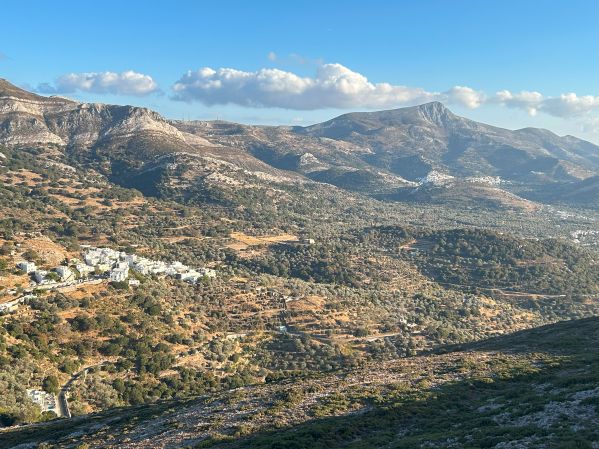
A scenic half-hour hike from ELaiolithos, suitable for most fitness levels, leads you to a tranquil hilltop sanctuary with 360° breathtaking panoramic views of Naxos’ most awe-inspiring landscapes. From this vantage point, marvel at the island’s tallest peaks, including Koronos, Fanari, Mount Zeus, and Nifiotisa. Surrounding the peaks, over 10 charming villages dot the hillsides, each telling its own tale of timeless traditions and a slower pace of life.
Below, the vast Drymalia Valley stretches out—the largest in the Cyclades—home to over 400,000 perrenial olive and citrus trees, many of which are over 1,000 years old, embodying the island’s rich agricultural heritage. On clear days, the view extends beyond Naxos to neighboring islands, their silhouettes rising gently from the Aegean Sea, creating a scene of serene beauty that feels like stepping into a dream.
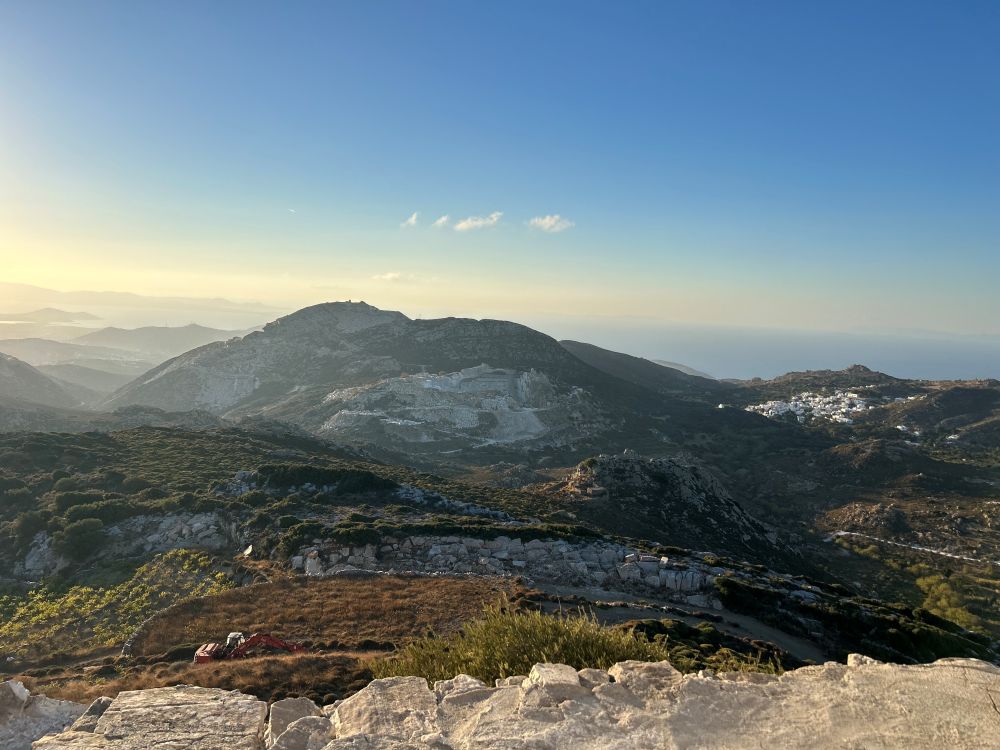
The chapel is not just a site of worship—it is a sanctuary inviting introspection and a connection to the divine. Surrounded by the vast tranquility of nature, it offers an ideal setting for reflection, prayer, or moments of pure stillness. Visitors frequently describe an overwhelming sense of peace at the summit, as though they’ve stepped beyond the hustle of daily life into a timeless space where the beauty of creation takes center stage.
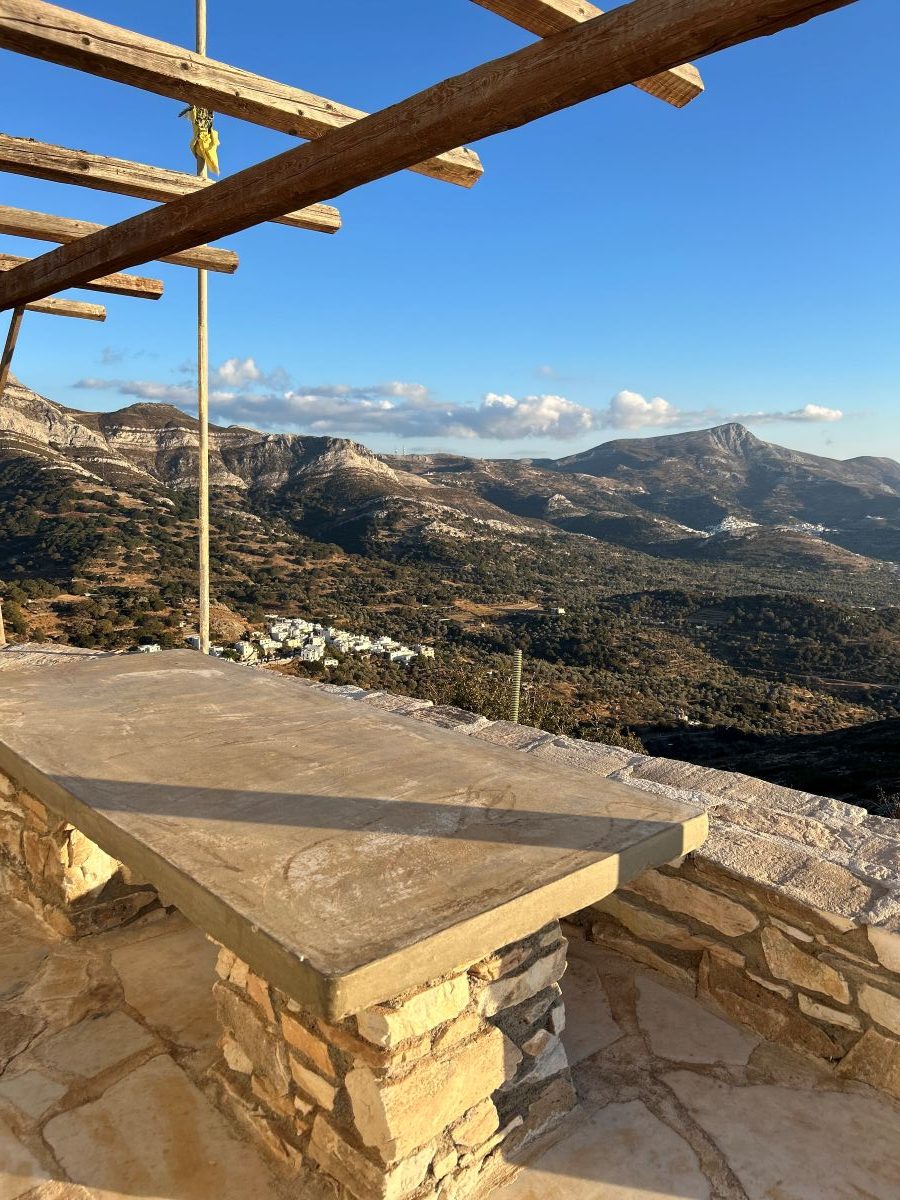
In this article, we will guide you through what to expect on this awe-inspiring hike and explain why it should be on your must-things-to-do list during your visit to Naxos. From panoramic views to a spiritual connection with nature, this trail offers an unparalleled experience. Along the way, we’ll delve into the profound significance of Profitis Elias in both Greek culture and religion, including his biblical story. The chapel itself embodies a tradition of situating places of worship on the highest peaks, symbolizing a connection to the heavens. We’ll also uncover the deeper meaning behind the choice of such elevated locations for chapels dedicated to him.
The Beauty of the Summit: A View into the Past and Present
Reaching the summit of Profitis Elias is not just a spiritual journey but also an immersion into the stunning natural landscape of Naxos. The trail winds through rugged, rocky terrain characteristic of the island, offering glimpses of Naxos’ rich flora and fauna along the way. The path is lined with a mix of Mediterranean herbs and wildflowers that infuse the air with fragrant notes. As you walk, you’ll likely encounter aromatic sage, thyme, and oregano—plants that have been used for centuries by the island’s residents in both cooking and traditional medicine. In spring and early summer, the hills come alive with the vibrant colors of wildflowers, creating a breathtaking natural tapestry.
The landscape is dotted with shepherds’ houses, small stone structures where local shepherds once took refuge as they watched over their flocks. These humble homes offer a glimpse into the island’s pastoral traditions, reminding visitors of a time when life was dictated by the rhythm of nature. You can still see goats grazing on the hillsides, much like they have for generations, their bells ringing softly in the distance.
The paths you walk on are not new—they are ancient trails, once the main thoroughfares for islanders traveling between villages or to go to their fields. Before modern roads, these stone-lined trails connected the people of Naxos, allowing them to transport goods, attend religious services, and visit family. The dry-stone walls that line these paths are another remnant of the past, built by hand to mark boundaries and protect cultivated land from erosion. Walking these paths, you get a sense of the hard work and simple beauty that characterized life in this mountainous region long before the advent of asphalt roads and modern conveniences.
As you make your way up to Profitis Elias, you are not just hiking through nature—you are walking in the footsteps of generations of islanders, experiencing the same views and paths that their ancestors did. The silence and stillness of the surroundings allow for moments of introspection and a deeper appreciation for the island’s history and natural beauty.
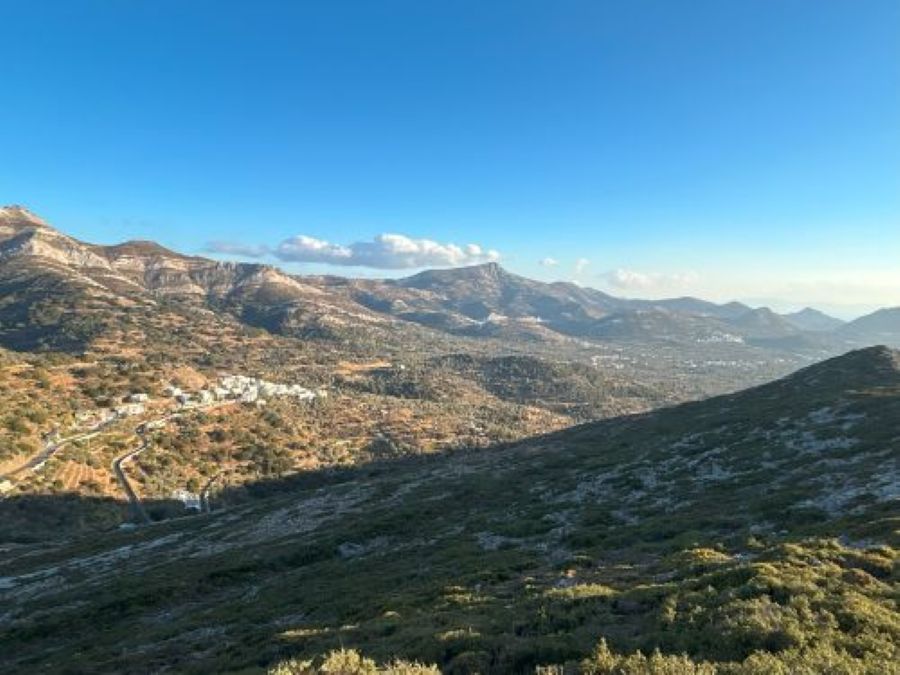
A Place for Reflection, Gratitude and a 360-degree View of the Island’s Natural Wonders
The chapel of Profitis Elias above ELaiolithos is a perfect embodiment of the tradition of building hilltop churches in honor of the prophet. Perched at this altitude, it offers not only a place of spiritual retreat but also a visual feast for the senses. From the summit, visitors can enjoy a 360-degree view of the island’s natural wonders! The summit’s breathtaking views and serene environment inspire reflection and gratitude that can only be found in such tranquil surroundings. Whether you are religious or not, the sheer beauty of the landscape invites contemplation.
Here, surrounded by nature, it is easy to feel connected to something greater than yourself. On most days, the sweeping view extends beyond Naxos, allowing visitors to see neighboring Cycladic islands, making it a truly magical experience. Whether at dawn or just before sunset, the sight of the sun rising or sinking into the horizon, casting golden hues across the landscape, is an unforgettable moment of connection with both nature and the divine.
Many visitors use this opportunity to meditate or pray, feeling a deep connection to the divine in this sacred space. The chapel itself, small and unadorned, stands as a humble yet powerful reminder of the spiritual significance of the location. Whether you are seeking solace, inspiration, or simply a moment of quiet, the summit of Profitis Elias provides the perfect setting.
ELaiolithos’ guests describe the experience of visiting this spot as unique and one that leaves a lasting impression!
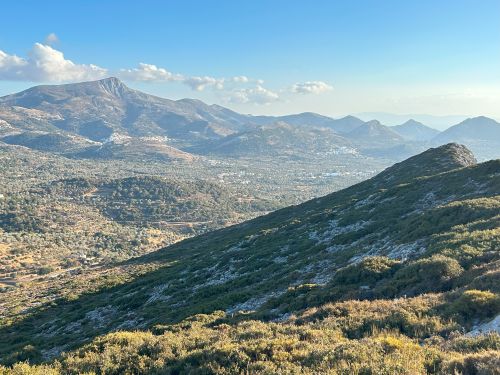
Trail Overview and Insights
The trail begins just under the Agia Varvara church, veering to the right along a gravel road that circles the mountain from the back. As you progress, the road briefly becomes asphalt before the ancient path begins to the left.
As you ascend, breathtaking views unfold: the Koronos Mountain and its peaks, the valley at its base, Kinidharos village, ancient pathways once used by locals to reach their fields, marble quarries, adjacent islands, and the vast Aegean Sea stretching to the horizon.
The summit offers a moment to pause, take in the breathtaking views, and soak in the scenery. The entire island of Naxos seems to unfold before you.Having visited Mount Zeus many times, I can say its views are majestic—after all, it’s the highest mountain in the Cyclades. But what sets Profitis Elias apart is its proximity to the landscape. While Mount Zeus provides distant views, the vantage point from Profitis Elias offers an intimate connection to the terrain. Here, you can take in the island up close, and its beauty leaves you speechless as you gaze upon the landscape.
The mountains, with their pyramid-like peaks, create a captivating visual spectacle, one summit after another—taller and smaller—forming a layered, natural masterpiece. As you descend from the front side of the mountain, the experience continues, with the Agia Varvara church guiding you like a compass. Following the old villagers’ path, with just a hiking stick in hand, you’ll easily make your way down, immersed in this incredible landscape.
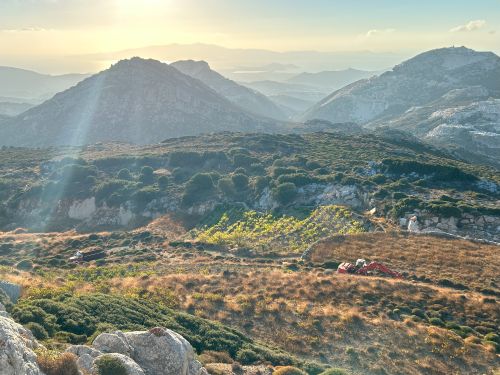
The Biblical Story of Prophet Elijah
Prophet Elijah, or Profitis Elias as he is known in Greek, is a revered figure in Christianity, Judaism, and Islam -he lived in the 9th or 10th century BC. His story is primarily told in the Old Testament, specifically in the Books of Kings. Elijah is remembered for his unwavering devotion to God, his acts of miraculous power, and his fierce opposition to idolatry. He is one of the few biblical figures who did not die but was instead taken up into heaven in a chariot of fire, a scene that has captivated the imaginations of believers for centuries.
According to the Old Testament, Prophet Elijah was a powerful and revered Jewish spiritual figure who lived during the 9th or 10th century BC. His Hebrew name, Eliyahu, translates to “My God is Yahweh,” emphasizing his role as a defender of monotheism during a time of widespread idolatry in Israel. The Hellenized version of his name, Elias or Ilias, is how he is known in the Greek Orthodox tradition.
Elijah’s story begins during the reign of King Ahab of Israel, a time when the worship of the pagan god Baal was prevalent, thanks in part to Ahab’s wife, Jezebel. Elijah stood as a lone voice defending the worship of the one true God, Yahweh, in the face of widespread idolatry. In one of the most famous episodes, Elijah challenges the prophets of Baal to a test on Mount Carmel, where God sends fire from heaven to consume Elijah’s sacrifice, proving His supremacy over Baal.
According to tradition, Elijah also foretold the coming of Christ over 800 years before His birth, further cementing his role as a key figure in Christian theology.
The Bible also records Elijah as a prophet who performed miracles, such as providing sustenance to those in need, raising the dead, and predicting a great drought as a divine punishment for Israel’s sins. After his victory over the prophets of Baal, Elijah fled to the desert and took refuge in a cave on Mount Horeb, where he experienced a profound encounter with God. The climax of his story comes when Elijah, nearing the end of his earthly ministry, is taken up into heaven in a fiery chariot, symbolizing his extraordinary faith and closeness to God.
Elijah’s ascension is significant for several reasons. In Christian tradition, it prefigures Christ’s own ascension into heaven, and Elijah is also seen as a symbol of the faithful who will be taken up at the Second Coming of Christ. His role as a mediator between God and the people, as well as his status as a prophet who did not experience death, make him a particularly revered figure in Orthodox Christianity.
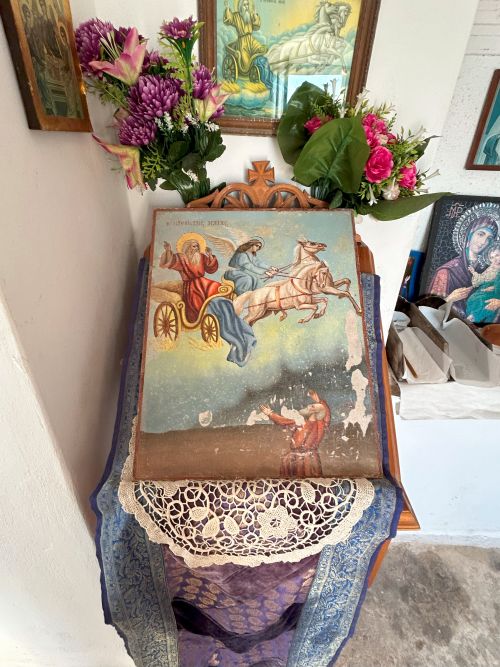
Why Chapels Dedicated to Profitis Elias Are Built on Hilltops and Mountain Peaks
The tradition of building chapels dedicated to Profitis Elias on hilltops and mountain peaks is deeply rooted in both religious symbolism and cultural practices in Greece.The elevated location represents Elias’ connection to the divine, as well as the ancient belief that mountaintops are closer to God. In Greece, these chapels not only serve as places of worship but also function as symbols of vigilance and protection, watching over the land below. His story of being lifted to heaven from a mountain has influenced the tradition of building chapels dedicated to him on high places, symbolically bridging the gap between heaven and earth.
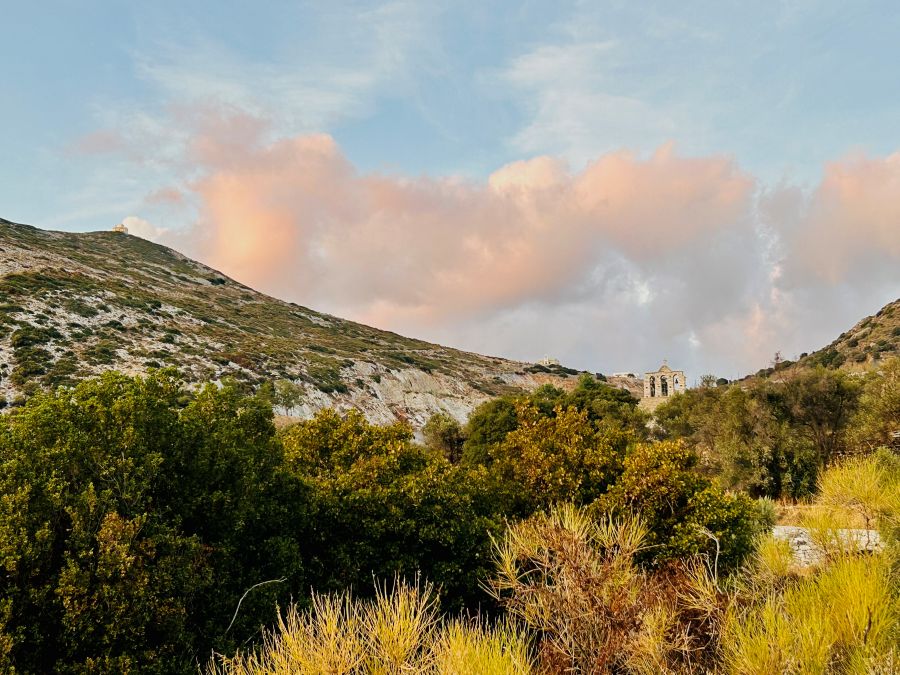
Several factors contribute to the tradition of building chapels dedicated to Profitis Elias on mountaintops:
- Spiritual Significance: In both Orthodox Christian and ancient Greek traditions, mountains have been considered sacred. The ancient Greeks believed gods resided on peaks like Mount Olympus, and this connection continues in the Christian faith with Profitis Elias acting as a mediator between heaven and earth. These high locations serve to honor both ancient traditions and the role of the prophet.
- Biblical Significance: The ascension of Prophet Elias into heaven, in a fiery chariot, adds a profound biblical reason for hilltop chapels. The mountaintop symbolizes his closeness to God and his connection between the earthly and the divine. Placing chapels at elevated points honors his ascent and offers a space for worshippers to feel spiritually connected to the divine.
- Association with Nature and the Elements: Prophet Elias is traditionally linked to natural elements like fire, rain, and wind. Building chapels on mountain peaks allows worshippers to connect with these natural forces, seeking Elias’ intercession for favorable weather, particularly rain for crops. This belief also ties into the idea of nature’s raw power, as Elias experienced on Mount Carmel and Mount Horeb.
- Ancient Sacred Spaces: In ancient Greece, mountaintops were considered sacred, with temples dedicated to gods. This pre-Christian tradition influenced the decision to build chapels on high peaks, as the role of Profitis Elias fits the concept of sacred heights, creating a space for worship and reflection.
- Protection and Vigilance: The hilltop location provides a commanding view, symbolizing Elias’ role as a protector of the faithful. These chapels are often seen as watchtowers, offering a sense of vigilance and divine protection from natural disasters or adversity.
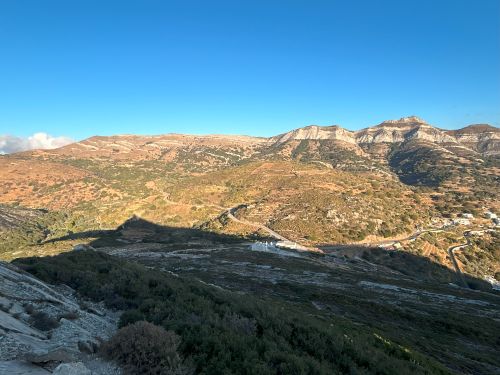
The Enduring Significance of Profitis Elias for Greeks
In the Greek Orthodox Church, Prophet Elijah is one of the most venerated Old Testament figures. On his feast day, July 20th, communities across Greece hold celebrations in his honor. Many of these festivities take place at hilltop chapels like the one above ELaiolithos, where locals and visitors gather for religious services, followed by feasts, music, and dancing. These events celebrate not only the prophet himself but also the rich cultural and religious traditions that have been passed down through generations.
In the Orthodox iconography of Profitis Elias, he is often depicted as an older man with a long beard, seated in his fiery chariot or standing on a mountain, gazing toward the sky. This imagery emphasizes his connection to the divine and his role as a mediator between heaven and earth. Elijah’s story is also tied to rain and weather, as one of his miracles involved praying for an end to a drought in Israel, a connection that further cements his association with the natural elements.
For Greeks, the figure of Profitis Elias holds a deep, multifaceted significance. His association with nature, particularly with rain and weather, makes him a protector of farmers and shepherds, whose livelihoods depend on favorable conditions. The chapels dedicated to him are not just places of worship but also symbols of gratitude and protection, where people come to seek his blessings.
All the chapels dedicated to Profitis Elias are often small and unadorned, with few icons and minimal decoration, typically left unguarded for much of the year. However, during spring, summer, and fall, they become popular destinations for both Greek and international hikers. The walking paths leading to these chapels, including the one atop ELaiolithos, offer breathtaking views and provide relatively easy hikes, making them accessible for outdoor enthusiasts seeking both spiritual connection and natural beauty.
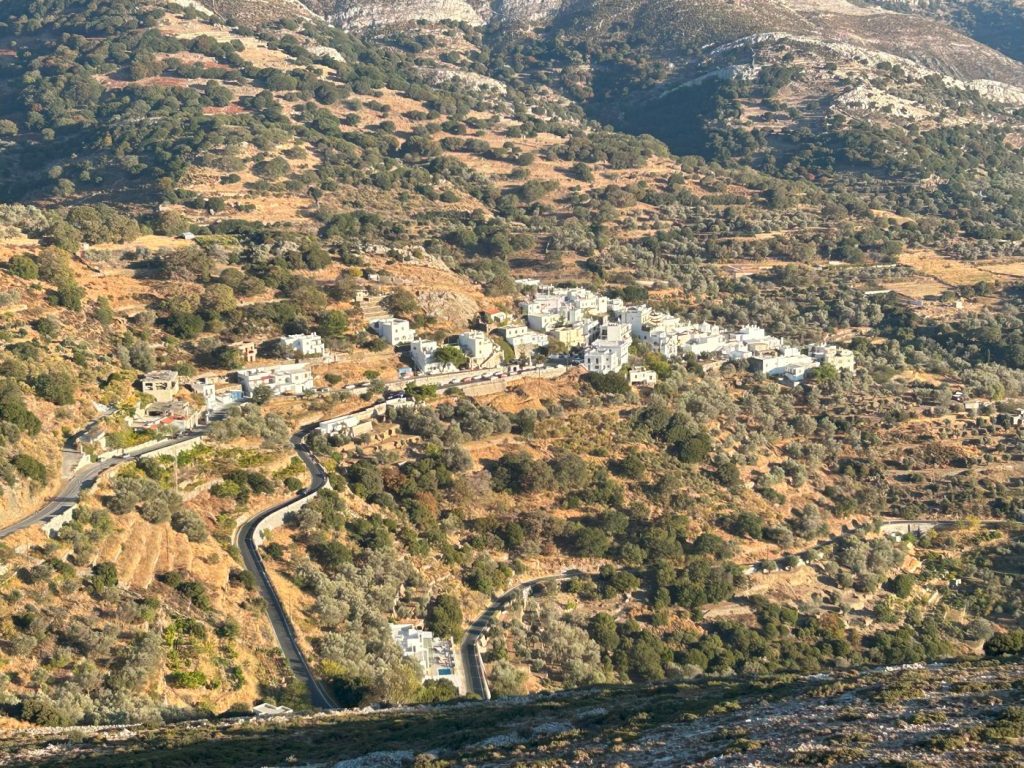
Conclusion
The chapel of Profitis Elias, perched on the hill above ELaiolithos, is a place where the spiritual, historical, and natural beauty of Naxos converge and inspire and uplift those who visit. The journey to the summit offers more than just a chance to witness stunning views—it provides a window into the past, a glimpse into the lives of the island’s ancestors, and a space for reflection and meditation. Whether you come for the hike, the history, or the spiritual experience, a visit to Profitis Elias is sure to leave you with a deep sense of peace and connection to the timeless beauty of the Cyclades.
In the end, the chapel and its surroundings invite you to step away from the fast pace of modern life and immerse yourself in the tranquility of the island’s hills, just as generations of worshippers and wanderers have done before you. Stay at ELaiolithos and let this sacred place be a part of your journey into culture, nature, peace, and gratitude.
The magic of Profitis Elias offers a journey to tranquility that goes beyond words—a journey you will carry with you long after you descend the hill.
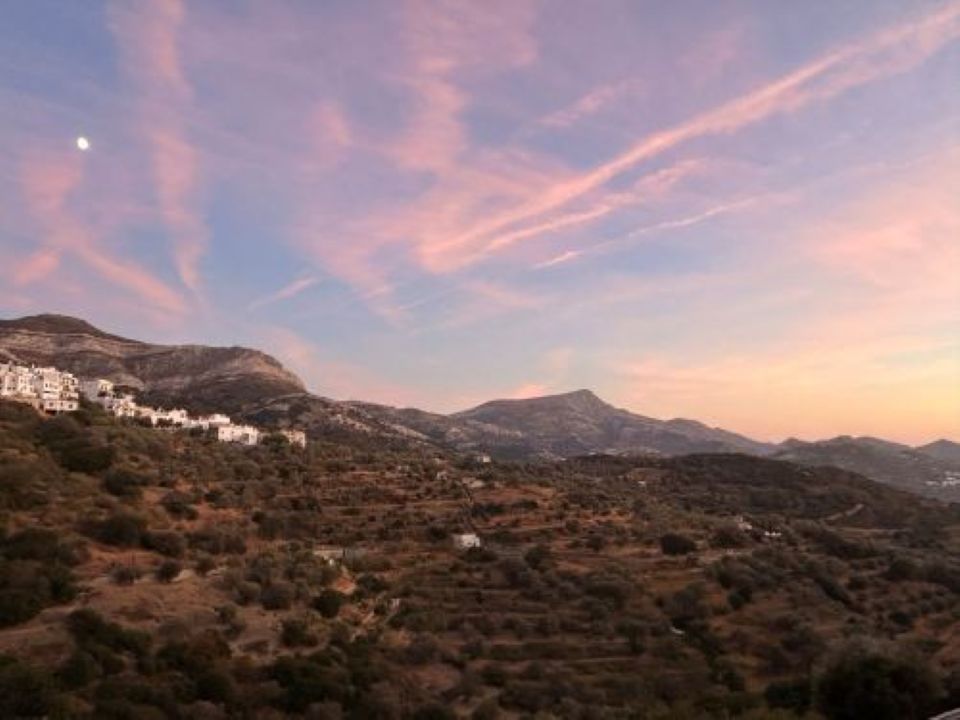
Stay at ELaiolithos and Experience the Magic of Naxos
To truly immerse yourself in the stunning natural beauty, spiritual serenity, and rich cultural heritage that Naxos has to offer, a stay at ELaiolithos is an experience you won’t want to miss. Nestled in the heart of this captivating island, ELaiolithos offers the perfect base for exploring the breathtaking landscapes, including the majestic Profitis Elias chapel just a hike away. Let the tranquility of the island and the panoramic views inspire your soul, while our personalized services cater to your every need. Come stay with us at ELaiolithos and discover the hidden gems of Naxos in a place where nature, culture, and peace meet in harmony.
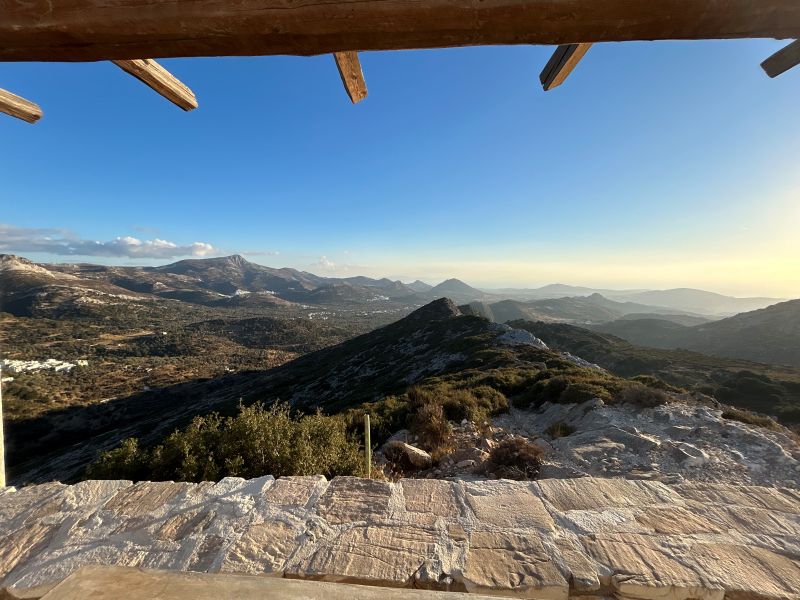
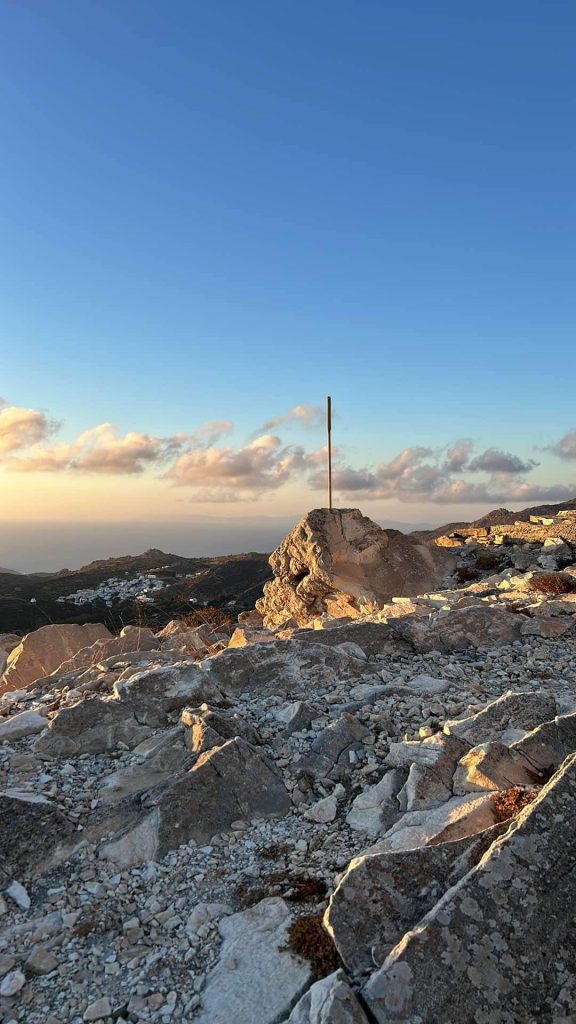
We can’t wait to welcome you!







